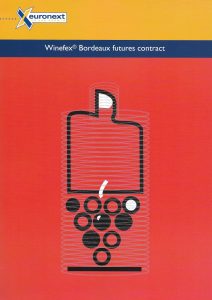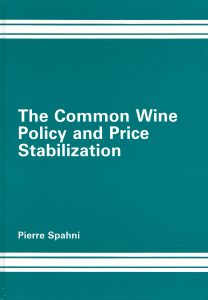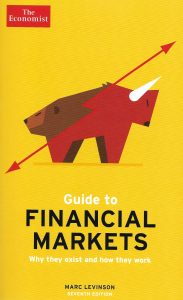WINE FUTURES
Waning price support, rising financial instability and recurring natural hazards warrant the need to provide wine professionals with some means of hedging their incomes against price volatility (risk). The best way to achieve stabilisation is through openly traded price contracts, and wine futures happen to be one of them. Careless wording has left many people confused about what they really are – or were. The page on wine futures provides a few definitions and illustrations of this powerful (and therefore controversial) financial instrument.
***
FUTURES PAST?
Several attempts have been made to render some parts of the wine market more liquid – and more transparent and efficient at the same time. But could these initiatives also bring about more stability to the prices paid to wine/grape producers as well as to those charged to consumers? Some twenty years ago, producers of Bordeaux en primeur (sold forward in cask, in the spring following harvest) and merchants dealing in these fine wines around the world were given a serious opportunity to reduce their exposure to risk by trading in proper wine futures.
Futures contracts are a powerful financial instrument that makes it possible to transfer price volatility (risk) from people who seek to avoid it to those who wish to take it. They allow buyers and sellers of the goods to cover – in full or in part – their normal transactions against unwanted price changes, by using a proven technique called hedging. Investors (speculators) provide the necessary liquidity for this to happen. And since futures are essentially used for hedging, less than 5% of the volumes traded on futures exchanges typically result in physical transactions (i.e. in the goods being either delivered to or collected from the exchange) when the contracts reach maturity.
In September 2001, the Pan-European exchange Euronext* launched what should be considered the world’s first proper wine futures under the name ‘Winefex Bordeaux’, for the 2000 and 2001 vintages. This came weeks after the fine wine traders Bordeauxindex had opened up their own on-line ‘two-way price service’ for Bordeaux 2000 en primeur.
Strictly speaking, en primeur wine sales are forwards and not futures. Some draw a sharp distinction between the two types of contracts, the difference being that futures are interchangeable (because of their standard terms) whereas forwards are not. It is the interchangeability of the contracts that makes hedging possible.

The main difference between the two services was that whilst Bordeauxindex.com (now BI.com) agreed to act as an honest broker (market maker) and thus to buy and sell en primeur (forward) contracts in dozens of individual wines in a continuous way (it still does), the futures exchange Winefex.com offered the possibility to trade in three different futures contracts, each defined on a basket of 140 wines from Bordeaux with an en primeur history of at least two years (see brochure). Winefex.com also had the expertise of Europe’s leading futures exchange Euronext, who owned MATIF (Marché à terme des instruments financiers) and LIFFE (London International Financial Futures Exchange).
The advent of wine futures horrified the wine establishment, mainly because of the populist view that futures could only increase instability. Yet according to The Economist, in January 2001, trading on Bordeauxindex.com was already having a sobering effect on the inflated en primeur price of the 2000 vintage and was likely to impact on the next. The price of the 2001 vintage was itself being traded on the Winefex exchange at that time and the next batch of futures contracts which were due to open in July, for the 2002 vintage (i.e. months before the grapes are even picked and nearly a year prior to the date at which the en primeur prices are officially announced), should have come to reinforce Winefex’s stabilising properties. Sadly, as with many new contracts, trading proved too thin and was suspended after the set trial period of nine months. The timing of their presentation in London, on the 11th of September 2001, was also most unfortunate.
The fairly complex specification of the Winefex contracts may have deterred some in the wine trade from using wine futures as an effective tool for managing risk in their day-to-day business. When it launched them, Euronext was confident that once futures’ effectiveness had been proven, producers and traders would overcome their usual scepticism and become keen users of them, as had been the case in other markets. It hoped it could then extend futures to other wines from Bordeaux (e.g. to génériques – wines that are traded in bulk, before their accréditation, and that made up 60% of the region’s sizable production of 555 million litres in 2000/01). Wines from other well-known regions of France and the world were meant to be added to the list later. But such plans were apparently too disruptive of the traditional ways in which most of the Bordeaux wine trade liked to operate.
* set up in 2000 as the merger of the Paris, Brussels and Amsterdam exchanges, Euronext merged with the New York Stock Exchange and was acquired by the Intercontinental Exchange Group later, which spun it off in 2014.
First published on April 8th, 2011. Updated on September 1st, 2020
DEFINITIONS
Quotations from The Economist’s Guide to Financial Markets – Why they exist and how they work (7th ed., by Marc Levinson. Profile Books Ltd, London, 2018).
Futures: ” A futures contract is a derivative, because its price and terms are derived from an underlying asset, sometimes known as the underlying. It represents a deal between two investors who may not be known to each other and are unaware of one another’s motives. Futures and options investors operate from one of two fundamental motives: hedging (this involves the use of futures or options to offset specific risks) or speculation (this involves trading with the intention of profiting from changes in the prices of futures or options contracts).”
Forwards: “are the simplest variety of derivative contract. A forward contract is an agreement to set a price now for something to be delivered in the future. One type of forward, a futures contract, is traded in standardised form on exchanges.”
Hedging: “This involves futures or options to offset specific risks – typically against a price fall for a producer and a price rise for a buyer. In every trade the two parties take opposite positions. The buyer of the contract, who agrees to receive the commodities specified, is said to be in a long position. The seller […] in a short position. It may not own the commodities it has agreed to deliver, but it is obliged to have them or to pay their value in cash at the expiry of the contract. Once a trade has been completed, the participants are both obligated to the exchange rather than to each other. Either party separately may terminate its contract at any point by arranging an offset (e.g. a producer deciding in July to end his September delivery obligation, would buy at the price current in July the same number of September contracts that he previously sold, and the two sets of contracts would cancel each other out). This is often referred to as liquidation of the initial contracts. A hedger is likely to regard any loss on the futures market as a sort of insurance premium.”
Speculation: “This involves trading with the intention of profiting from changes in the prices of futures or options contracts, rather than from a desire to hedge specific risks. Although speculation is often derided as an unproductive activity, it is essential to the smooth functioning of the market. By buying and selling contracts with great frequency, speculators vastly increase liquidity: the supply of money in the markets. Without the liquidity that speculators provide, the futures and options markets would be less attractive to hedgers because it would be more difficult to buy and sell contracts at favourable prices. Firms that use futures or options for hedging may also be active as speculators.”
Specification: “A futures contract contains the specifications of the transaction. The specifications of all contracts in a given asset on a given exchange are identical, apart from the expiration date. This standardisation is an important feature of futures markets as it makes contracts interchangeable, freeing traders and investors from the need to worry about unusual provisions. The specifications cover the following: contract size, quality, delivery date, price limits (the smallest allowable price movement, known as a tick or a point), position limits (to prevent a speculator from cornering the market by owning a large proportion of the contracts and thus being able to manipulate the price) and settlement. Most futures contracts do not lead to the actual delivery of the underlying products. However, the contract specifies when and where delivery must be made and may provide for the alternative of cash settlement.”
RISK and STABILISATION
My 1988 book The Common Wine Policy and Price Stabilization and an earlier doctoral dissertation at the University of Newcastle upon Tyne, proposed the introduction of futures contracts for ordinary/table wine as a means of reducing risk in income to producers (and merchants) who wished to do so, and as an alternative to costly market intervention by the European Community.
This book is out of print. As owner of the copyrights, I am offering you excerpts that shed light on the following issues:

- How buffer stocks schemes work and why they usually fail. <View>
- What risk is and what price stabilisation means in the context of wine. <View>
- The stabilising effect of futures on wine prices and how market participants could hedge. <View>
***
